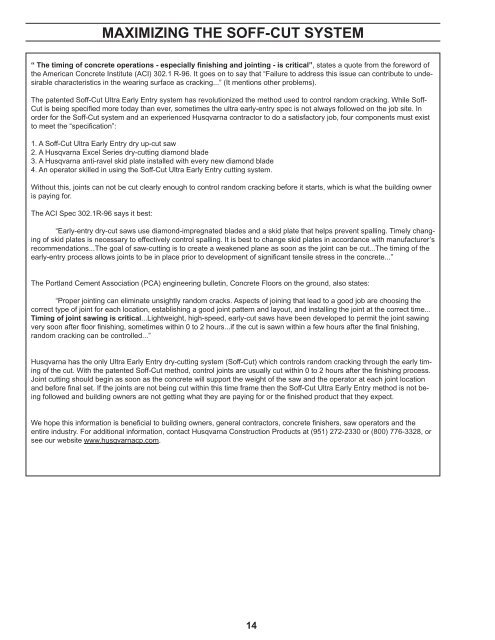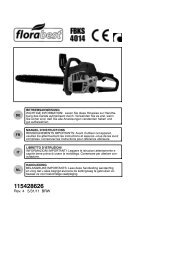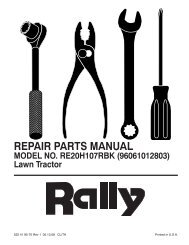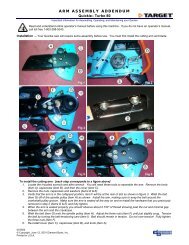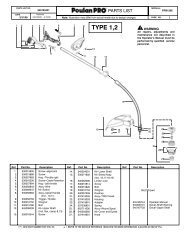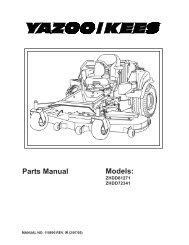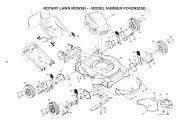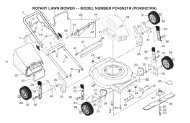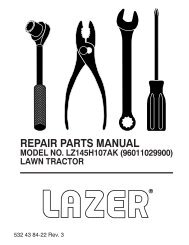OM, Soff-Cut 4200, 2010-01, EN - Klippo
OM, Soff-Cut 4200, 2010-01, EN - Klippo
OM, Soff-Cut 4200, 2010-01, EN - Klippo
Create successful ePaper yourself
Turn your PDF publications into a flip-book with our unique Google optimized e-Paper software.
MAXIMIZING THE SOFF-CUT SYSTEM<br />
“ The timing of concrete operations - especially finishing and jointing - is critical”, states a quote from the foreword of<br />
the American Concrete Institute (ACI) 302.1 R-96. It goes on to say that “Failure to address this issue can contribute to undesirable<br />
characteristics in the wearing surface as cracking...” (It mentions other problems).<br />
The patented <strong>Soff</strong>-<strong>Cut</strong> Ultra Early Entry system has revolutionized the method used to control random cracking. While <strong>Soff</strong>-<br />
<strong>Cut</strong> is being specified more today than ever, sometimes the ultra early-entry spec is not always followed on the job site. In<br />
order for the <strong>Soff</strong>-<strong>Cut</strong> system and an experienced Husqvarna contractor to do a satisfactory job, four components must exist<br />
to meet the “specification”:<br />
1. A <strong>Soff</strong>-<strong>Cut</strong> Ultra Early Entry dry up-cut saw<br />
2. A Husqvarna Excel Series dry-cutting diamond blade<br />
3. A Husqvarna anti-ravel skid plate installed with every new diamond blade<br />
4. An operator skilled in using the <strong>Soff</strong>-<strong>Cut</strong> Ultra Early Entry cutting system.<br />
Without this, joints can not be cut clearly enough to control random cracking before it starts, which is what the building owner<br />
is paying for.<br />
The ACI Spec 302.1R-96 says it best:<br />
“Early-entry dry-cut saws use diamond-impregnated blades and a skid plate that helps prevent spalling. Timely changing<br />
of skid plates is necessary to effectively control spalling. It is best to change skid plates in accordance with manufacturer’s<br />
recommendations...The goal of saw-cutting is to create a weakened plane as soon as the joint can be cut...The timing of the<br />
early-entry process allows joints to be in place prior to development of significant tensile stress in the concrete...”<br />
The Portland Cement Association (PCA) engineering bulletin, Concrete Floors on the ground, also states:<br />
“Proper jointing can eliminate unsightly random cracks. Aspects of joining that lead to a good job are choosing the<br />
correct type of joint for each location, establishing a good joint pattern and layout, and installing the joint at the correct time...<br />
Timing of joint sawing is critical...Lightweight, high-speed, early-cut saws have been developed to permit the joint sawing<br />
very soon after floor finishing, sometimes within 0 to 2 hours...if the cut is sawn within a few hours after the final finishing,<br />
random cracking can be controlled...”<br />
Husqvarna has the only Ultra Early Entry dry-cutting system (<strong>Soff</strong>-<strong>Cut</strong>) which controls random cracking through the early timing<br />
of the cut. With the patented <strong>Soff</strong>-<strong>Cut</strong> method, control joints are usually cut within 0 to 2 hours after the finishing process.<br />
Joint cutting should begin as soon as the concrete will support the weight of the saw and the operator at each joint location<br />
and before final set. If the joints are not being cut within this time frame then the <strong>Soff</strong>-<strong>Cut</strong> Ultra Early Entry method is not being<br />
followed and building owners are not getting what they are paying for or the finished product that they expect.<br />
We hope this information is beneficial to building owners, general contractors, concrete finishers, saw operators and the<br />
entire industry. For additional information, contact Husqvarna Construction Products at (951) 272-2330 or (800) 776-3328, or<br />
see our website www.husqvarnacp.com.<br />
14


